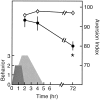cAMP response element-binding protein in the amygdala is required for long- but not short-term conditioned taste aversion memory
- PMID: 9334416
- PMCID: PMC6573742
- DOI: 10.1523/JNEUROSCI.17-21-08443.1997
cAMP response element-binding protein in the amygdala is required for long- but not short-term conditioned taste aversion memory
Abstract
In conditioned taste aversion (CTA) organisms learn to avoid a taste if the first encounter with that taste is followed by transient poisoning. The neural mechanisms that subserve this robust and long-lasting association of taste and malaise have not yet been elucidated, but several brain areas have been implicated in the process, including the amygdala. In this study we investigated the role of amygdala in general, and the cAMP response element-binding protein (CREB) in the amygdala in particular, in CTA learning and memory. Toward that end, we combined antisense technology in vivo with behavioral, molecular, and histochemical analysis. Local microinjection of phosphorothioate-modified oligodeoxynucleotides (ODNs) antisense to CREB into the rat amygdala several hours before CTA training transiently reduced the level of CREB protein during training and impaired CTA memory when tested 3-5 d later. In comparison, sense ODNs had no effect on memory. The effect of antisense was not attributable to differential tissue damage and was site-specific. CREB antisense in the amygdala had no effect on retrieval of CTA memory once it had been formed, and did not affect short-term CTA memory. We propose that the amygdala, specifically the central nucleus, is required for the establishment of long-term CTA memory in the behaving rat; that the process involves long-term changes, subserved by CRE-regulated gene expression, in amygdala neurons; and that the amygdala may retain some CTA-relevant information over time rather than merely modulating the gustatory trace during acquisition of CTA.
Figures



Similar articles
-
Transient expression of c-Fos in rat amygdala during training is required for encoding conditioned taste aversion memory.Learn Mem. 1996 Jul-Aug;3(1):31-41. doi: 10.1101/lm.3.1.31. Learn Mem. 1996. PMID: 10456074
-
Region-specific involvement of BDNF secretion and synthesis in conditioned taste aversion memory formation.J Neurosci. 2011 Feb 9;31(6):2079-90. doi: 10.1523/JNEUROSCI.5348-10.2011. J Neurosci. 2011. PMID: 21307245 Free PMC article.
-
Differential involvement of gustatory insular cortex and amygdala in the acquisition and retrieval of conditioned taste aversion in rats.Behav Brain Res. 1992 Nov 30;52(1):91-7. doi: 10.1016/s0166-4328(05)80328-6. Behav Brain Res. 1992. PMID: 1335264
-
Conditioned taste aversion as a learning and memory paradigm.Behav Brain Res. 2001 Nov 1;125(1-2):205-13. doi: 10.1016/s0166-4328(01)00302-3. Behav Brain Res. 2001. PMID: 11682112 Review.
-
Inducible repression of CREB function disrupts amygdala-dependent memory.Neurobiol Learn Mem. 2004 Sep;82(2):159-63. doi: 10.1016/j.nlm.2004.05.008. Neurobiol Learn Mem. 2004. PMID: 15341801 Review.
Cited by
-
Clocking In Time to Gate Memory Processes: The Circadian Clock Is Part of the Ins and Outs of Memory.Neural Plast. 2018 Apr 12;2018:6238989. doi: 10.1155/2018/6238989. eCollection 2018. Neural Plast. 2018. PMID: 29849561 Free PMC article. Review.
-
Context and the renewal of conditioned taste aversion: the role of rat dorsal hippocampus examined by electrolytic lesion.Cogn Neurodyn. 2012 Oct;6(5):399-407. doi: 10.1007/s11571-012-9208-y. Epub 2012 Jun 13. Cogn Neurodyn. 2012. PMID: 24082961 Free PMC article.
-
Increasing CREB in the auditory thalamus enhances memory and generalization of auditory conditioned fear.Learn Mem. 2008 May 30;15(6):443-53. doi: 10.1101/lm.993608. Print 2008 Jun. Learn Mem. 2008. PMID: 18519545 Free PMC article.
-
Epigenetic regulation of memory by acetylation and methylation of chromatin: implications in neurological disorders, aging, and addiction.Neuromolecular Med. 2015 Jun;17(2):97-110. doi: 10.1007/s12017-014-8306-x. Epub 2014 Apr 29. Neuromolecular Med. 2015. PMID: 24777294 Review.
-
Identification and Characterization of the V(D)J Recombination Activating Gene 1 in Long-Term Memory of Context Fear Conditioning.Neural Plast. 2016;2016:1752176. doi: 10.1155/2016/1752176. Epub 2015 Dec 30. Neural Plast. 2016. PMID: 26843989 Free PMC article.
References
-
- Bartsch D, Ghirardi M, Skehel PA, Karl KA, Herder SP, Chen M, Bailey CH, Kandel ER. Aplysia CREB2 represses long-term facilitation: relief of repression converts transient facilitation into long-term functional and structural change. Cell. 1995;83:979–992. - PubMed
-
- Bermudez-Rattoni F, Grijalva CV, Kiefer SW, Garcia J. Flavor-illness aversions: the role of the amygdala in the acquisition of taste-potentiated odor aversions. Physiol Behav. 1986;38:503–508. - PubMed
-
- Bourtchuladze R, Frenguelli B, Blendy J, Cioffi D, Schutz G, Silva AJ. Deficient long-term memory in mice with a targeted mutation of the cAMP-responsive element-binding protein. Cell. 1994;79:59–68. - PubMed
-
- Bures J, Buresova O, Kriveanek J. Brain and behavior: paradigms for research on neuronal mechanisms. Wiley; New York: 1988.
-
- Burnette WW. Western blotting: electrophoretic transfer of proteins from sodium dodecyl sulfate-polyacrylamide gels to unmodified nitrocellulose and radiographic detection with antibody and radioiodinated protein A. Anal Biochem. 1981;112:195–203. - PubMed
Publication types
MeSH terms
Substances
LinkOut - more resources
Full Text Sources
Other Literature Sources
Medical
